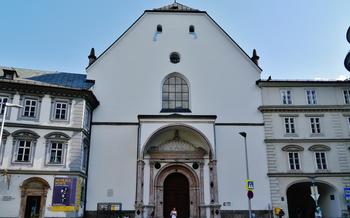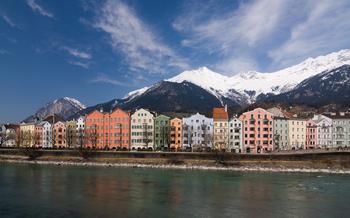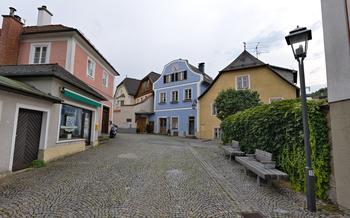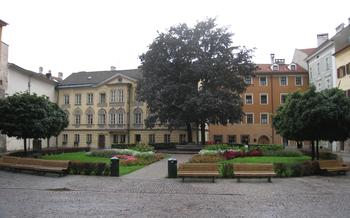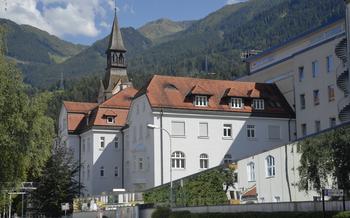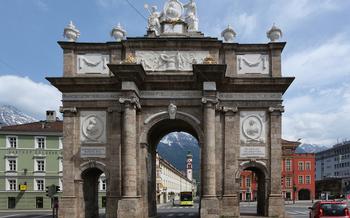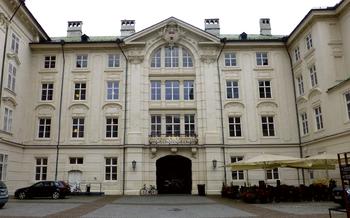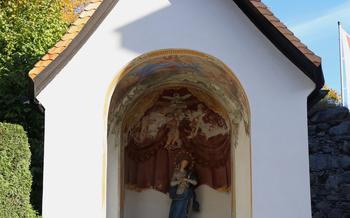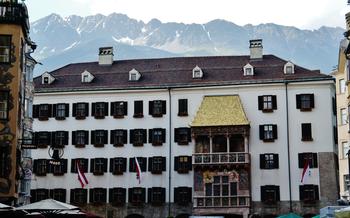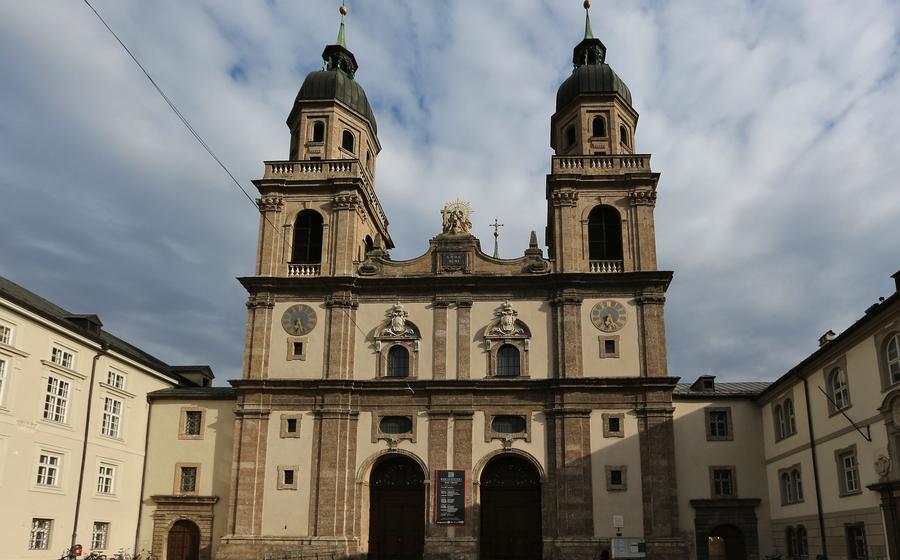
The Jesuit Church
- Historical Significance
- Interior Design
- Organ and Music
- Hofkirche (Court Church)
- Landmark Sights
- Location and Accessibility
- Masses and Services
- Admission Fees
- Photography and Videography
- Dress Code and Etiquette
- Souvenirs and Shops
- Nearby Attractions
- Food and Dining
- Insider Tip: Unveiling the Secret Courtyard
Historical Significance
Nestled in the heart of Innsbruck, the Jesuit Church stands as a testament to the city's rich history and deep-rooted Catholic faith. Its construction, initiated in the 16th century, was a strategic move by the Jesuit order, a powerful force in the Counter-Reformation, to reclaim the city for Catholicism. The church's imposing façade, adorned with intricate carvings and sculptures, reflects the Baroque architectural style prevalent during its time. Its grandeur and opulence were meant to showcase the power and influence of the Catholic Church, serving as a beacon of hope and inspiration for the faithful during a period of religious turmoil.
Interior Design
The Jesuit Church proudly displays its Baroque splendor as soon as one steps inside. The walls and ceilings are adorned with intricate stucco work, creating a sense of opulence and grandeur. The ceiling frescoes, painted by renowned artists, depict biblical scenes and celestial figures, adding to the divine atmosphere. The altars within the church are equally breathtaking, crafted with meticulous detail and embellished with gold and marble. Among these, the high altar stands out as the centerpiece, showcasing a radiant painting of the Assumption of Mary. The side altars are equally impressive, each dedicated to a different saint, and adorned with exquisite sculptures and paintings.
Organ and Music
The Jesuit Church boasts a magnificent Baroque organ, renowned for its exceptional acoustics and captivating sound. Constructed by the renowned organ builder Johann Caspar Schmahl in the early 18th century, the organ's intricate carvings, gilded pipes, and elegant design are a testament to the era's exquisite craftsmanship. With its impressive 3,500 pipes, the organ produces a rich and resonant sound that fills the church's grand interior, creating an awe-inspiring atmosphere.
Throughout history, the organ has played a pivotal role in the musical life of Innsbruck. It has been the stage for countless concerts, recitals, and religious ceremonies, featuring renowned organists and musicians from around the world. The church's exceptional acoustics make it an ideal venue for classical music performances, allowing the organ's majestic tones to reverberate through the vaulted ceilings and enchant listeners.
Regular concerts and performances are held in the Jesuit Church, allowing visitors to experience the organ's grandeur firsthand. From classical organ recitals to choral performances and contemporary compositions, the church's musical offerings cater to diverse tastes and preferences. Attending a concert in this sacred space is a truly immersive experience, transporting listeners to a realm of musical enchantment.
Hofkirche (Court Church)
The Hofkirche, also known as the Court Church, is an awe-inspiring sight adjacent to the Jesuit Church. It serves as the final resting place for Emperor Maximilian I, the Holy Roman Emperor, and other members of the Habsburg dynasty. Built in the 16th century, the Hofkirche is a captivating blend of Gothic and Renaissance architectural styles. Its most striking feature is the intricate silver cenotaph, an elaborate monument adorned with over 280 bronze figures, each representing a significant person from Maximilian's life. The church also houses impressive sculptures, including those of the emperor and his family, crafted by renowned artists like Peter Vischer the Elder and Gilg Sesselschreiber. The Hofkirche stands as a testament to Habsburg grandeur and a must-visit site for history and art enthusiasts.
Landmark Sights
The Jesuit Church's iconic onion-shaped dome dominates Innsbruck's skyline, a beacon of Baroque splendor visible from afar. Its distinctive green copper roof, adorned with intricate patterns, resembles an inverted pine cone, a symbol of eternal life and resurrection. The majestic bell tower, soaring high above the city, offers panoramic vistas of Innsbruck's charming cityscape, the surrounding Tyrolean mountains, and the glistening River Inn meandering through the valley.
A short stroll away, visitors can marvel at the "Golden Roof" (Goldenes Dachl), a dazzling landmark in the heart of Innsbruck's Old Town. This ornate balcony, covered with 2,657 fire-gilded copper tiles, was commissioned by Emperor Maximilian I in the early 16th century and served as a royal viewing platform for tournaments, festivals, and other grand events. The intricate Gothic tracery and delicate carvings that adorn the Golden Roof showcase the exquisite craftsmanship of the era, making it a must-see attraction for any visitor to Innsbruck.
Location and Accessibility
The Jesuit Church stands majestically in the heart of Innsbruck's Old Town, inviting history buffs and architecture enthusiasts to explore its grandeur. Nestled amidst cobblestone streets and charming buildings, the church is a centerpiece of the city's rich heritage. It's easily accessible by foot, allowing you to soak in the sights and sounds of the vibrant Old Town as you approach. Alternatively, you can hop on a bicycle or take advantage of the city's efficient public transportation network to reach the church conveniently. As an added bonus, the Jesuit Church forms part of the UNESCO World Heritage Site, further emphasizing its significance and inviting you to delve into the cultural tapestry of Innsbruck.
Masses and Services
The Jesuit Church offers regular masses in German, as well as masses in other languages on specific days of the week. These masses provide a solemn and spiritual experience for visitors, allowing them to connect with the local Catholic community. The church also holds special events and celebrations throughout the year, such as concerts, exhibitions, and festivals, which offer a unique opportunity to witness the rich traditions and cultural heritage of Innsbruck. For visitors interested in attending mass, it is advisable to check the church's website or contact the parish office for specific mass times and booking information.
Admission Fees
Visiting the Jesuit Church is generally free of charge, allowing visitors to admire its grandeur without financial constraints. However, there are certain instances when a nominal admission fee may be applicable. During special events, exhibitions, or guided tours, a fee might be levied to cover administrative costs and maintenance expenses. It's always advisable to check with the church authorities or the official website for the most up-to-date information regarding admission fees.
For those seeking a comprehensive experience, guided tours are highly recommended. Led by knowledgeable guides, these tours offer a deeper insight into the history, architecture, and significance of the church. While there may be a fee associated with guided tours, the investment is well worth it, as it provides a unique opportunity to learn more about this remarkable landmark.
Photography and Videography
Capturing the grandeur of the Jesuit Church through photography or videography is a tempting endeavor for visitors. However, it's essential to be mindful of the sacred nature of the site and adhere to the church's photography policy. Photography and videography are generally permitted for personal use, but the use of tripods, flash photography, and professional equipment may be restricted. To fully appreciate the church's beauty, consider leaving your camera behind and simply soaking in the atmosphere. However, if you do wish to capture some memories, be sure to do so respectfully, without disturbing others or disrupting any ongoing services.
For the best photographic opportunities, head to the front of the church to capture the stunning altar and intricate ceiling frescoes. The exterior of the church, with its iconic onion-shaped dome, also makes for a striking subject. And don't forget to venture into the Hofkirche next door to photograph the impressive silver cenotaph of Emperor Maximilian I.
Dress Code and Etiquette
When visiting the Jesuit Church, it is essential to exhibit respect for its sacred nature. While there is no strict dress code, visitors should dress modestly and appropriately, avoiding shorts, tank tops, or excessively revealing clothing. Additionally, silence and reverence are expected inside the church, as it is a place of worship for many. Speaking quietly and refraining from disruptive behavior are signs of respect for both the church and its congregants. It is also customary to bow or nod your head when passing by the altar or statues of saints as a sign of reverence. By following these simple guidelines, visitors can help preserve the sanctity of this beautiful and historic place.
Souvenirs and Shops
Within the Jesuit Church, visitors can find a small shop selling a variety of souvenirs, postcards, and religious items. These items range from simple rosaries and crucifixes to more elaborate statues and paintings. The shop also offers a selection of books and pamphlets about the history of the church and the Jesuit order.
Just outside the church, visitors will find a number of other shops and stalls selling a variety of souvenirs and gifts. These shops offer a wide range of items, including traditional Austrian handicrafts, Tyrolean specialties, and unique souvenirs from Innsbruck.
One unique souvenir that visitors can find in Innsbruck is a replica of the famous "Goldenes Dachl" (Golden Roof). This ornate balcony, located just a short walk from the Jesuit Church, is one of the most iconic landmarks in the city. Visitors can purchase a miniature replica of the Golden Roof to take home as a reminder of their visit to Innsbruck.
Nearby Attractions
A visit to the Jesuit Church is an excellent opportunity to explore Innsbruck's rich history and culture. Just a stone's throw away, you'll find the magnificent Hofburg Imperial Palace, a former imperial residence that now houses several museums and institutions. Admire the ornate architecture and explore exhibitions showcasing the history of Tyrol and the Habsburg dynasty.
Stroll further into the Old Town and discover the Innsbruck Cathedral, a Gothic masterpiece renowned for its stunning stained glass windows and intricate carvings. Take a moment to soak in the sacred atmosphere and appreciate the architectural grandeur.
Innsbruck offers a treasure trove of historical and cultural attractions, making it a walker's paradise. Craft a leisurely walking itinerary, allowing ample time to explore each site and uncover the city's hidden gems. Discover charming cobblestone streets, picturesque courtyards, and enchanting boutiques nestled amidst the historic buildings.
Whether you're a history buff, an art enthusiast, or simply seeking a memorable travel experience, Innsbruck has something to offer everyone. Embrace the city's vibrant energy, immerse yourself in its rich heritage, and create lasting memories in this captivating Alpine gem.
Food and Dining
After exploring the wonders of the Jesuit Church, satisfy your taste buds with a culinary adventure in Innsbruck's Old Town. Just steps away, you'll find an array of cafes, restaurants, and food markets offering a delightful fusion of traditional Austrian cuisine and international flavors. Don't miss the chance to sample hearty Tyrolean specialties like Käsespätzle (cheese noodles) or Tiroler Gröstl (fried potatoes with meat and eggs). For a sweet treat, indulge in a slice of Sachertorte (chocolate cake) or a fluffy Kaiserschmarrn (shredded pancake). Whether you prefer a cozy cafe, a charming restaurant, or a vibrant food market, Innsbruck's culinary scene is sure to delight your palate. Insider tip: Look for restaurants serving Brettljause, a traditional Tyrolean platter of cured meats, cheeses, and bread—a perfect way to savor the region's flavors.
Insider Tip: Unveiling the Secret Courtyard
For an enchanting surprise, venture beyond the main church building to discover a hidden gem—the serene courtyard of the Jesuit monastery. This tranquil oasis, tucked away from the bustling city streets, offers a moment of respite and reflection. Admire the beautifully preserved Renaissance architecture, soak in the tranquility of the surroundings, and allow the peaceful atmosphere to transport you back in time. The courtyard is often overlooked by visitors, but it holds a charm that is sure to leave a lasting impression.
